Gujarat Board GSEB Solutions Class 10 Maths Chapter 11 Constructions Ex 11.1 Textbook Questions and Answers.
Gujarat Board Textbook Solutions Class 10 Maths Chapter 11 Constructions Ex 11.1
Question 1.
Draw a line segment of length 7.6 cm and divide it in the ratio 5 : 8. Measure the two parts.
Solution:
Steps of Construction
1. Draw AB = 7.6 cm
2. At A, draw an acute angle ∠BAX below BA.
3. On AX mark 13 (5 + 8) arcs A1, A2, …, A13.
4. Join B to A13.
5. From A5, draw A5C || A13B.
AC : CO = 5 : 8.
![]()
Justification:
In ΔABA13, A5C || A13
⇒ \(\frac {AC}{BC}\) = \(\frac{\mathrm{AA}_{5}}{\mathrm{A}_{5} \mathrm{A}_{13}}\) [Thales Theorem]
But \(\frac{\mathrm{AA}_{5}}{\mathrm{A}_{5} \mathrm{A}_{13}}\) = \(\frac {5}{8}\)
[By construction]
∴ \(\frac {AC}{BC}\) = \(\frac {5}{8}\)
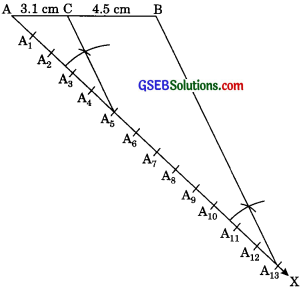
Question 2.
Construct a triangle of sides 4 cm, 5 cm and 6 cm and then a triangle similar to it whose sides are of the corresponding sides of the first triangle.
Solution:
Steps of Construction:
1. Draw ΔABC with AC = 6cm, AB = 5 cm, BC = 4 cm.
2. At A1 draw an acute angle∠CAX below the base AC.
3. Mark 3 arcs on AX such that AA1 = A1A2 = A2A3.
4. Join A3C.
5. Draw A2C’ || A3C
6. From C’ draw B’C’ || BC
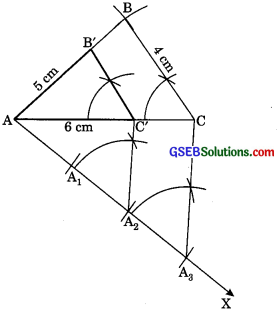
Thus, ΔAB’C’ is the required triangle.
Justification:
ΔAB’C’ ∼ ΔABC [AA similarity Rule]
\(\frac{\mathrm{AB}^{\prime}}{\mathrm{AB}}=\frac{\mathrm{AC}^{\prime}}{\mathrm{AC}}=\frac{\mathrm{B}^{\prime} \mathrm{C}^{\prime}}{\mathrm{BC}}\) ……….(1)
[Sides are proportional]
But \(\frac{A C^{\prime}}{A C}=\frac{A A_{2}}{A A_{3}}=\frac{2}{3}\) ………..(2)
From (1) and (2)
But \(\frac{A B^{\prime}}{A B}=\frac{A C^{\prime}}{A C}=\frac{B^{\prime} C^{\prime}}{B C}=\frac{2}{3}\)
![]()
Question 3.
Construct a triangle with sides 5 cm, 6 cm and 7 cm and then another triangle whose sides are \(\frac {5}{8}\) of the corresponding sides of the first triangle.
Solution:
1. Construct a ΔABC with AB = 7 cm, AC = 5 cm, BC = 6 cm
2. At A draw an acute ∠BAX below AB.
3. On AX, mark 7 arcs A1, A2, …, A7 such that
AA1 = A1A2 =…=A6A7.
4. Join A5B.
5. From A7 draw A7B’ || A5B meeting AB at B’ (extent AB to B’)
6. From B’ draw B’C’ || BC meeting AC at C’ [extend AC to C’]
AB’C’ is the required triangle each of whose sides is \(\frac {5}{8}\) of the corresponding sides of ΔABC.
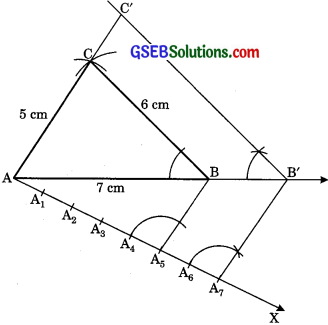
Justification:
\(\frac{C^{\prime} A}{C A}=\frac{A B^{\prime}}{A B}=\frac{C^{\prime} B^{\prime}}{C B}\) ………..(1)
[Sides are proportional]
But \(\frac{\mathrm{AB}^{\prime}}{\mathrm{AB}}=\frac{\mathrm{AA}_{7}}{\mathrm{AA}_{5}}\) = \(\frac {7}{5}\) ………(2)
From (1) and (2)
\(\frac{C^{\prime} A}{C A}=\frac{A B^{\prime}}{A B}=\frac{C^{\prime} B^{\prime}}{C B}\) = \(\frac {7}{5}\)
Question 4.
Construct an isosceles triangle whose base is 8 cm and altitude is 4 cm and then another triangle whose sides are 1 times the corresponding sides of the isosceles triangle. (CBSE 2017)
Solution:
Steps of Construction:
1. Draw a line segment BC = 8 cm.
2. Draw its perpendicular bisector AD (4 cm).
3. Joining AB and AC, we get isosceles triangle ABC
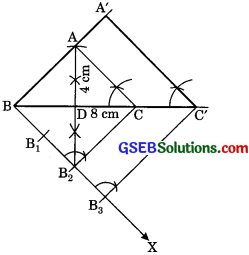
4. Construct an acute ∠CBX.
5. Along BX cut 3 arcs B1, B2 and B3 such that
BB1 = B1B2 = B2B3.
6. Join C to B2 and draw a line B3C’ || B2C [extend BC to C’]
7. From C’ draw C’A’ || CA [extend BA to A’]
∴ ΔA’BC’ is a required triangle.
Justification:
Now C’A’ || CA (By construction)
∴ ΔABC ∼ ΔA’BC’ [AA similarity criteria]
∴ \(\frac{\mathrm{A}^{\prime} \mathrm{B}}{\mathrm{AB}}=\frac{\mathrm{A}^{\prime} \mathrm{C}^{\prime}}{\mathrm{AC}}=\frac{\mathrm{BC}^{\prime}}{\mathrm{BC}}\) [Sides are proportional]
Now B3C’ || B2C (By construction)
∴ ΔBB3C’ – ΔBB2C [AA similarity criteria]
∴ \(\frac{\mathrm{BC}^{\prime}}{\mathrm{BC}}=\frac{\mathrm{BB}_{3}}{\mathrm{BB}_{2}}\) [Thales theorem]
But \(\frac{\mathrm{BB}_{3}}{\mathrm{BB}_{2}}=\frac{3}{2}\) (By construction]
∴ \(\frac{B C^{\prime}}{B C}=\frac{3}{2}\)
∴ \(\frac{\mathrm{A}^{\prime} \mathrm{B}}{\mathrm{AB}}=\frac{\mathrm{A}^{\prime} \mathrm{C}^{\prime}}{\mathrm{AC}}=\frac{\mathrm{BC}^{\prime}}{\mathrm{BC}}=\frac{3}{2}\)
![]()
Question 5.
Draw a triangle ABC with side BC = 6 cm, AB = 5 cm and ∠ABC = 60°. Then construct a triangle whose sides are \(\frac{3}{4}\) of the corresponding sides of the ABC. (CBSE 2015)
Solution:
Steps of Construction:
1. Draw a line segment BC = 6 cm.
2. At B draw ∠CBY = 60° on which take AB = 5 cm.
3. Join AC. ΔABC is required triangle.

4. From B, draw an acute ∠CBX downwards.
5. Mark four arcs B1, B2, B3, B4 on BX such that BB1 = B1B2 = B2B3 = B3B4.
6. Join B4C and from B3 draw B3C’ B4C.
7. From C’, draw A’C’ || AC.
When ΔA’BC’ is the required triangle whose sides are \(\frac{3}{4}\) of the corresponding sides of ΔABC.
Justification:
A’C’ || AC (By construction)
∴ ΔA’BC’ ∼ ΔABC (AA similarity Rule)
∴ \(\frac{\mathrm{BC}^{\prime}}{\mathrm{BC}}=\frac{\mathrm{BB}_{3}}{\mathrm{BB}_{2}}\) ………..(1)
[Sides are proportional]
But \(\frac{\mathrm{BC}^{\prime}}{\mathrm{BC}}=\frac{\mathrm{BB}_{3}}{\mathrm{BB}_{4}}=\frac{3}{4}\) ………….(2)
From (1) and (2)
\(\frac{\mathrm{A}^{\prime} \mathrm{B}}{\mathrm{AB}}=\frac{\mathrm{BC}^{\prime}}{\mathrm{BC}}=\frac{\mathrm{A}^{\prime} \mathrm{C}^{\prime}}{\mathrm{AC}}=\frac{3}{4}\)
![]()
Question 6.
Draw a triangle ABC with side BC = 7 cm, ∠B = 45°, ∠A = 105°. Then construct a triangle whose sides are \(\frac{3}{4}\) times the corresponding sides of the ΔABC. (CBSE 2012, 2017)
Solution:
Steps of Construction:
1. Draw a ABC with side BC = 7 cm, ∠B = 45°, ∠C = 30°
[∠C = 180° – 45° – 105° = 180° – 150° = 30°]
2. At B, draw an acute ∠CBX below BC.
3. On BX, mark the arcs B1, B2, B3, B4 such
that BB1 = B1B2 = B2B3 = B1B4.
4. Join B3C.
5. Draw B4C’|| B3C [Extend BC to C’]
6. Draw C’A’ || CA [Extend BA to A’]
∴ ΔA’BC’ is the required triangle.
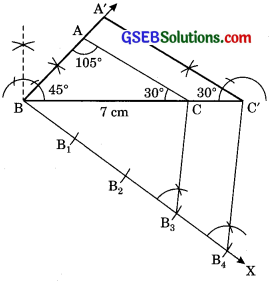
Justification:
C’A’ || CA (By construction)
∴ ΔABC ∼ ΔA’BC’ (AA similarity Criteria)
\(\frac{\mathrm{A}^{\prime} \mathrm{B}}{\mathrm{AB}}=\frac{\mathrm{A}^{\prime} \mathrm{C}^{\prime}}{\mathrm{AC}}=\frac{\mathrm{BC}^{\prime}}{\mathrm{BC}}\) ………(1) [Corresponding sides are proportional]
Now B4C’ || B3C (By construction)
∴ \(\frac{\mathrm{BC}^{\prime}}{\mathrm{BC}}=\frac{\mathrm{BB}_{4}}{\mathrm{BB}_{3}}\) ……..(2)
[Thales theorem]
But = \(\frac{B B_{4}}{B B_{3}}=\frac{4}{3}\) ………(3) (By construction)
From (1) (2) and (3)
\(\frac{\mathrm{A}^{\prime} \mathrm{B}}{\mathrm{AB}}=\frac{\mathrm{A}^{\prime} \mathrm{C}^{\prime}}{\mathrm{AC}}=\frac{\mathrm{BC}^{\prime}}{\mathrm{BC}}=\frac{4}{3}\)
![]()
Question 7.
Draw a right triangle in which the sides (other than hypotenuse) are of lengths 4 cm and 3 cm. Then construct another triangle whose sides are times the corresponding sides of the given triangle. (CBSE 2010)
Solution:
1. Draw a line segment AB = 4 cm.
2. By making right angle at B. Draw BC = 3 cm.
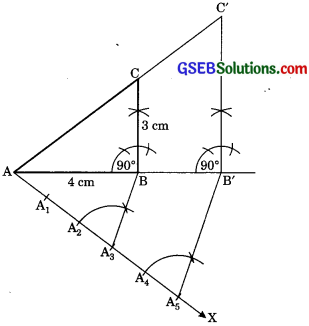
3. Join AC. ΔABC is the required right-angled triangle.
4. At A, Draw acute angle ∠BAX downwards.
5. On AX, mark 5 arcs A1, A2, A3, A4, A5 such
that AA1 = A1A2 = … = A4A5
6. Join A3B.
7. Draw A5B’|| A3B [Extend AB to B’]
8. Draw B1C’ || BC [Extend AC to C’]
Hence ΔAB’C’ is the required triangle
Justification:
ΔABC ∼ ΔABC(AA similarity Rule)
\(\frac{A B^{\prime}}{A B}=\frac{A C^{\prime}}{A C}=\frac{B^{\prime} C^{\prime}}{B C}\) ……..(1) [Sides are proportional]
But \(\frac{A B^{\prime}}{A B}=\frac{A A_{5}}{A A_{3}}=\frac{5}{3}\) ……(2)
From (1) and (2)
\(\frac{A B^{\prime}}{A B}=\frac{A C^{\prime}}{A C}=\frac{B^{\prime} C^{\prime}}{B C}=\frac{5}{3}\)
![]()